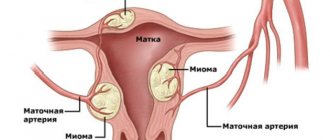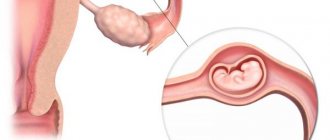- January 19, 2019
- Gynecology
- Olga Simchenko
It often happens that a woman experiences heavy bleeding during menstruation for no apparent reason. It is very important to know what to do about this to prevent complications from developing. Severe bleeding with clots threatens the development of anemia, as well as more serious diseases.
To eliminate the unpleasant consequences of this condition, you need to initially study the causes of its occurrence and methods of treatment. Therapy can be carried out using hemostatic drugs or folk remedies.
What should menstruation be like?
During menstruation, a woman normally produces 50-80 milliliters of blood. The first days of the cycle pass with bright-colored blood discharge, and then gradually it becomes darker.
The shade of menstrual blood varies from woman to woman. Stronger discharge may occur during a sudden rise, physical activity or movement. In addition to blood, mucus or small clots appear. There is a characteristic odor present. This is considered the norm. However, if heavy bleeding occurs during menstruation or, conversely, it is too scanty, then you should consult a doctor, as this may be a sign of pathology.
How to determine the state of the body by blood
You need to monitor your blood condition. Any violations are a reason to consult a doctor. Pink blood indicates low estrogen levels. In this case, there is less discharge than usual. The disorder is the result of excessive physical exertion. Treatment is required to prevent complications.
A watery consistency indicates a nutrient deficiency. The symptom is typical for women who follow a diet or limit their diet. Also indicates an advanced form of anemia. Diagnosis required.
Excessive thickness is the result of increased estrogen levels. Progesterone, on the contrary, is reduced. Hormonal imbalances can be caused by external factors or existing diseases. Neoplasms should be excluded.
Sexually transmitted diseases are indicated by intensely colored discharge. The blood remains scarlet until the very last day.
Causes of menstruation with clots
This condition often frightens a woman very much, especially if it occurs frequently and over a long period of time. The causes of heavy bleeding during menstruation with clots can be associated with various types of disorders. The main pathologies and conditions include the following:
- endometrial hyperplasia;
- uterine fibroids;
- hormonal disorders;
- spiral in the uterus;
- excess of B vitamins.
Endometrial hyperplasia is characterized by significant growth of the endometrium. This problem is most often observed with hormonal disorders, diabetes, hypertension, and obesity. Uterine fibroids are benign tumors. It provokes menstrual irregularities, as well as heavy and painful periods with blood clots.
Endometrial polyposis can also cause this condition. At the same time, its cells grow and can reach quite large sizes. Heavy bleeding with clots may occur after childbirth. This is considered the norm. However, if the temperature rises, this may indicate that there are parts of the placenta remaining in the uterus, so it is worth visiting a doctor.
If severe bleeding with clots occurs, the reasons for this may be anatomical disorders in the uterus or other anomalies that interfere with the normal outflow of secretions. Brown menstruation is mainly observed in cases of anemia.
Red blood in large quantities can indicate uterine bleeding, which poses a great danger to the patient’s life, so you need to urgently go to the hospital. If menstruation is accompanied by fever and abdominal pain, this may indicate an ectopic pregnancy.
Severe bleeding with clots can occur in women who abuse alcohol, smoke, and are also subject to constant stress.
Scarlet discharge during menstruation (menstruation)
Menstruation is a natural physiological process that any sexually mature woman who does not have health problems regularly experiences.
From a physiological point of view, the appearance of bloody discharge indicates the beginning of the process of rejection of excess cellular tissue formed in the uterine cavity on the eve of ovulation. The day your period arrives is considered the starting point for counting the duration of the menstrual cycle.
- Menstrual flow is characterized by:
- 1 low coagulation coefficient;
- 2 darker shade compared to vascular blood.
- The peculiarities of menstrual flow are determined by their chemical composition, in particular, the increased content of enzymes.
- To understand why discharge of scarlet blood appeared during menstruation, it is necessary to understand which menstruation should be considered normal, and which menstruation may be malfunctioning.
- Menstruation, which occurs without deviations, is characterized by standard discharge:
- 1 regularity of discharge;
- 2 absence of painful sensations, the stomach should not hurt during menstruation (menstruation), and if pain appears in the stomach (lower abdomen), then it should be felt in intensity as discomfort or a weak nagging pain in the lower abdomen;
- 3 dark shade of discharge during menstruation (menstruation) is considered normal;
- 4 discharges of average duration and intensity.
- What are the types of menstruation disorders, deviations of menstruation, menstruation cycle? The most common menstrual abnormalities include:
- 1 change in the color and/or smell of bleeding during menstruation. If the spotting during menstruation becomes a different color, when scarlet blood appears instead of menstruation and other symptoms;
- 2 a menstrual cycle that is too short or too long can also be considered deviations defined by irregularities in the menstrual cycle;
- 3 irregular periods (menstruation);
- 4 the appearance of symptoms such as itching or an unpleasant odor from the vagina against the background of scarlet discharge is one of the symptoms of a woman’s menstrual cycle;
- 5, a reason to consult a doctor can also be a change in the usual course of menstruation, when menstruation does not proceed as usual, if menstruation comes too early or there is a delay in menstruation, if the discharge is too heavy or, on the contrary, scanty discharge appears during menstruation.
Not all changes during menstruation indicate the presence of pathology. For example, it is allowed to change the color of the discharge during menstruation in favor of a darker shade at the end of the cycle. On average, during menstruation, a woman loses a couple of tens of milliliters of blood per day, but this figure does not take into account the individual characteristics of the female body, so it can vary upward or downward depending on the specific situation.
- In what cases should you immediately make an appointment with a gynecologist if your periods are abnormal:
- 1 appearance of scarlet blood (normally, the color of the discharge should change from light to dark, but not vice versa);
- 2 appearance of blood clots.
- You can read in more detail about which periods can be considered abnormal in the article: vaginal discharge is yellow, green, brown, yellow, causes of abnormal discharge during menstruation.
The most common menstrual cycle disorders include the appearance of scarlet discharge, when scarlet blood appears during menstruation. To determine what causes such a pathology as scarlet blood during menstruation and what it can mean, it is worth turning to the physiology of the female body.
The individual characteristics of the female body have a huge impact on the course of menstruation. For example, it has been observed that women with low hemoglobin levels have menstrual discharge that is lighter in color and has low viscosity. Therefore, red blood during menstruation may not always be a sign of a problem.
Very often, scarlet spotting is a consequence of taking hormonal contraceptive pills, other means of hormonal contraception, such as an IUD (intrauterine device), hormonal patch and others.
Scarlet blood during menstruation is often observed in adolescents during the formation of the menstrual cycle, as well as in women during menopause. Another reason that causes the appearance of scarlet blood during menstruation is hypomenorrhea, accompanied by rare and scanty discharge.
Scarlet blood during menstruation does not always signal health problems. For example, at the beginning of the cycle, the presence of red discharge with a sour odor is quite acceptable.
You should be wary if scarlet blood does not disappear by the middle of the cycle or appears at the end of menstruation, and its smell is similar to the smell of vascular blood. In this case, we are talking not so much about menstruation, but about bleeding, which may indicate the presence of serious health problems.
Therefore, if there is any suspicious discharge, you should immediately consult a doctor. So, if scarlet blood or bright red discharge began in the middle of the cycle, or bright red bloody discharge appeared after the end of the menstrual cycle, then these are reasons to make an appointment with a gynecologist.
If scarlet blood and pink discharge appeared before the onset of menstruation, then useful information on this issue can be found in the article: causes of pink discharge before menstruation.
If during menstruation a woman experiences scarlet blood, if the vaginal discharge is bright scarlet in color and along with it there are blood clots, clots of scarlet discharge, then this may indicate the process of endometrial rejection, which in turn occurs due to the process of non-fertilization at the right time.
Very often this process is accompanied by heavy bleeding from the vagina, clots of scarlet blood and other unpleasant symptoms often appear.
The reasons for the appearance of scarlet blood clots during menstruation may be the use of a hormonal IUD or intrauterine device as the main method of contraception. But when using an intrauterine device, the clots are usually burgundy in color, not scarlet. Black or burgundy clots during menstruation may also indicate the development of certain gynecological problems.
Women often wonder why bright red discharge and scarlet blood appeared during menstruation. The reasons for the appearance of scarlet discharge are very diverse.
So, the reasons for the appearance of scarlet blood during menstruation may be a simple hormonal imbalance or be a consequence of the use of a hormonal IUD (intrauterine device) as the main method of contraception.
The reasons for the appearance of scarlet blood during menstruation may also be due to the appearance of an infection that is transmitted through sexual contact.
Other reasons for the appearance of symptoms such as bright scarlet blood during menstruation (menstruation) are the appearance of a tumor in the uterus, the appearance of pregnancy in which pathologies can be observed, be the result of a recent abortion, or be symptoms of recently performed gynecological operations.
Also, scarlet blood instead of menstruation is often a consequence of taking hormonal birth control pills. You can learn more about why scarlet blood appeared instead of menstruation while taking hormonal OCs at an appointment with your gynecologist. Considering that scarlet discharge can indicate many serious health problems, it is recommended to make an appointment with a specialist with such a problem.
- It is especially important to consult a doctor if scarlet discharge appears along with mucus clots, if there is scarlet discharge and an unpleasant odor, if the discharge is accompanied by blood clots.
- Taking into account all the above described reasons for the failure of menstruation, we can conclude that scarlet blood discharge during menstruation (menstruation) is most often the result of problems such as:
- 1 sexually transmitted diseases;
- 2 hormonal imbalances;
- 3 postoperative complications;
- 4 oncological diseases;
- 5 termination of pregnancy;
- 6 pathologies of fetal development in the womb;
- 7 individual intolerance to means of protection against unwanted pregnancy (intrauterine device, OK)
Timely treatment of the disease, when a woman first notices changes in her menstrual cycle, if menstruation lasts too long or if menstruation fails due to the appearance of scarlet blood from the vagina, scarlet discharge, is the key to health and longevity.
That is why, if there are any changes in the menstrual cycle (color, smell, volume, intensity of discharge), you should immediately contact a specialist.
You can read about dangerous and non-dangerous reasons for the appearance of discharge before menstruation in the article: what discharge before menstruation can be considered normal.
The main types of pathologies during menstruation:
- Treatment of scarlet blood during menstruation does not involve eliminating the symptom itself in the form of scarlet-colored bleeding, but diagnosing the cause of the appearance of such symptoms and subsequent treatment of the problem.
Depending on what disease provoked the change in the menstrual cycle, what problem or disease caused the appearance of scarlet blood during menstruation, the doctor may prescribe: - 1 physiotherapy;
- 2 antibacterial/antiviral/hormonal drugs;
- 3 specialized diet;
- 4 surgical intervention.
- Often, moderate physical activity, vitamins, in particular E and C (which is especially important in the case of low hemoglobin levels), as well as herbal medicines are prescribed as auxiliary means of treating and eliminating such a symptom as scarlet blood during menstruation.
Perhaps the main recommendation that any woman should heed is to visit a gynecologist every six months. Early diagnosis of pathologies has saved more than one life, not only of the women themselves, but also of the children they bear. Life is priceless. Take care of yourself.
Main reasons
For the body, significant blood loss is considered a very dangerous condition. Heavy bleeding is mainly explained by a pathological process that occurs in the female reproductive system. Basically, such pathologies do not pose a threat to life, but they provoke a deterioration in health, low iron levels, anemia, and problems in sexual life. That is why, in order to prevent the occurrence of pathology, it is necessary to take into account the main provoking causes of severe bleeding. These include:
- abortion;
- infectious diseases;
- C-section;
- prolonged stress or depression;
- avitaminosis;
- frequent diets;
- blood clotting disorder;
- problems with hormonal levels.
Lifting heavy objects or exercising too intensely can also cause heavy bleeding. Inflammatory processes, neoplasms and gynecological pathologies have a great influence.
Kinds
The main types of bleeding include:
- dysfunctional;
- juvenile;
- breakthrough;
- profuse.
The main signs of dysfunctional bleeding are considered to be large blood loss and/or too long periods. The risk group mainly includes adolescents and women during menopause. The provoking factor is considered to be an excessive amount of sex hormones. To eliminate this pathology, hormonal therapy is required.
This type of bleeding is divided into ovulatory and anovulatory. The first is characterized by the manifestation of an abnormal cycle. This means that there is a small discharge or short periods, more than one month apart. Anovulatory symptoms are characterized by cycle disruption, significant blood loss, loss of appetite, poor health and drowsiness.
Juvenile bleeding may occur seasonally. This can be explained by the fact that the corpus luteum is not formed due to hormonal imbalance. Breakthrough bleeding occurs as a result of problems with the uterus, which can be caused by an intrauterine device. In addition, they can be caused by taking hormonal contraceptives.
Profuse blood loss is quite difficult to distinguish from normal menstruation, since they are not characterized by the presence of pain. The only sign may be a severe loss of fluid mobile connective tissue with scarlet discharge.
Periods are normal
The menstrual cycle in a woman’s body is regulated by hormones - estrogens and gestagens. Its successive phases are aimed at preparing for pregnancy and bearing a child. The phase change mechanism is as follows:
- If fertilization of the egg does not occur, then the genitals get rid of functional changes - menstruation occurs at the end of the cycle. For a healthy girl, this process is completely painless and has no consequences.
- This mechanism is repeated every month, as the average cycle takes about 28 days.
- Functionally, menstruation is bleeding, which is provoked by brain hormones, tearing away part of the inner layer of the uterus (endometrium). This bleeding takes from 3 to 7 days - deviations are symptoms of the disease.
Therefore, sexual health consists of two components - the normal cycle and the characteristics of menstrual blood.
Changes in the uterus during menstruation
The beginning of the period of discharge is provoked by the brain - under its influence, a large amount of hormones is released into the blood. They cause the onset of bleeding, as they lead to rejection of the functional layer of the endometrium:
- The first target is the spiral arteries of the inner membrane - partial destruction of their wall occurs. The blood released from them is still scarlet in color, as it is saturated with oxygen.
- Further, hormones cause increased secretion of mucus from the endometrial glands - it mixes with scarlet blood, contributing to its darkening.
- Thanks to the mucous secretion, menstruation becomes less liquid, but is better secreted and does not clot. This prevents infection from entering the uterus.
- The epithelial cells of the inner layer left without nutrition begin to die and flake off. Particles of tissue give the discharge greater viscosity and make it dark scarlet or cherry in color.
- Menstruation is accompanied by small rhythmic contractions of the uterus - this allows you to quickly remove discharge from the cavity. This also ensures that bleeding stops - the spiral arteries are compressed and shortened under the action of the muscles.
The duration of menstruation and their character depend on the activity of hormones. Scarlet color of blood does not always indicate illness, since the discharge consists of several components.
Menstrual blood
From a physiological point of view, it is no longer blood, but is a different biological fluid. When blood vessels are damaged, mucus from the glands of the uterus and vagina, as well as tissue particles, enters it. Therefore, menstruation is not scarlet, like arterial blood, but much darker. The discharge also has the following characteristics:
- The volume of discharge may vary, but should range from 10 to 70 milliliters. If there are too few of them, then they acquire a spreading character instead of a liquid one. Abundant amounts lead after some time to the development of anemia - a decrease in the number of red blood cells and hemoglobin due to bleeding.
- Menstruation should have a dark red or brown color - due to the mixing of blood with mucus and endometrial fragments. Scarlet color indicates a violation of the processes of stopping bleeding.
- Your period should not be too thin (like water) and should not have any clots. Due to the admixture of mucus, scarlet arterial blood does not clot, as platelets and fibrin threads are blocked. Therefore, the formation of a blood clot does not occur, so that blood does not accumulate in the uterine cavity.
- The discharge should be uniform, since alternating colors (scarlet and dark) and inclusions of tissue indicate an inflammatory process. It leads to detachment of the inner layer at different times, which slows down recovery.
And, most importantly, menstruation is normally painless and does not disrupt the usual way of life. If at this time there is a sharp deterioration in the condition and unpleasant symptoms, then this is a sign of a gynecological disease.
Signs of uterine bleeding
Often, a woman cannot accurately recognize when she has heavy bleeding during her period. Additionally, you need to monitor your well-being. The main signs of severe bleeding are:
- critical days last more than a week;
- the released blood exceeds the volume of 80 milliliters;
- irregular discharge;
- mainly observed during menopause or before puberty.
As a result of excessive blood loss, a woman may develop anemia. General health deteriorates significantly, headaches, weakness, problems with normal orientation in space, and frequent dizziness appear. Fainting occurs quite often. Bleeding from the nose often occurs, as well as bruises on the body. If heavy bleeding occurs during menstruation, you should immediately consult a doctor.
Short answer, where does the blood come from?
To answer this question briefly, blood comes from the uterus during menstruation. It flows out through the vagina.
=
=
The essence of the process is this: in girls by the age of 10-14 years (most often), puberty continues and menarche appears. Menarche is the first menstruation.
Menstruation is the process in which blood comes out of the vagina. She appears every 20-32 days. The menstrual cycle is established within a year after menarche.
From this moment on, the girl’s hormone levels and balance change. That is, the amount of LH (luteinizing) and FSH (follicle-stimulating) hormones changes during the cycle. Although until this moment the amount of these hormones was monotonous, that is, the same. Under the influence of these hormones (FSH and LH), the processes of growth and differentiation of the egg occur, as well as the activity of other sex hormones (estrogens and progesterone).
What to do if you are bleeding
If you have to change pads every hour, it means that you started bleeding heavily during menstruation. How to stop it? This must be addressed immediately to avoid health-threatening blood loss. Before the doctor arrives, you should try to reduce the intensity of the discharge.
To do this, you need to lie down comfortably with a pillow under your feet. The lower limbs should be higher than other parts of the body. Place a heating pad with cold water on your lower abdomen for 15 minutes. Drink plenty of sweet tea, water, and juices. It is important to consume fortified foods.
First aid for severe bleeding is very important, but after the situation improves, you should visit a doctor, since problems may be associated with more serious disorders in the body.
Carrying out diagnostics
To identify the cause of heavy bleeding during menstruation, you need to conduct a comprehensive diagnosis, which includes the following:
- general analysis of urine and blood;
- blood test for hormone levels and tumor markers;
- ultrasound diagnostics;
- hysteroscopy;
- diagnostic curettage.
All these diagnostic procedures help detect inflammation, anemia, impaired blood clotting, tumors, and hormonal disorders. If it is not possible to determine the cause of the disorder, the doctor prescribes a gynecological cleansing, and after that the biological material is sent for examination.
Why is the menstrual cycle accompanied by bleeding?
Blood loss during menstruation is caused by heavy menstruation. For some girls, this is a feature of the body. In such cases, the discharge with blood is more than 150 ml daily.
How to distinguish heavy periods from bleeding? Be wary when:
- the blood flows not thick, but thin;
- it is bright red;
- I have severe stomach pain throughout my period.
Bloody discharge signals a threat of miscarriage. Sometimes blood appears, but there is no pain.
Visit your gynecologist regularly and monitor your condition to avoid spontaneous abortion and heavy blood loss.
The following will happen before a miscarriage. Your stomach will begin to hurt very much - as if it were being cut. The blood will flow without stopping, not in portions. It will have a liquid consistency and large volume. After some time, there will be a strong desire to visit the restroom. There you will see a small clot the size of a bean. It will be dark brown in color.
In a normal pregnancy, the fetus is implanted in the uterus, and in an ectopic pregnancy, the fetus is implanted in the fallopian tube, ovaries, or elsewhere in the abdomen.
Some girls have an abnormal structure of the fallopian tubes from birth. Because of this, the fertilized egg cannot enter the uterus and begins to divide outside of it.
Discharge appears on the days of the expected menstruation and after them. Accompanied by the following symptoms:
- dizzy;
- feeling weak;
- cramping pain appears in the lower abdomen.
Sometimes an ectopic pregnancy does not manifest itself, and sometimes it makes itself felt at the first positive test result.
Menstrual-like red discharge signals serious pathological processes in the female body.
Let's look at the causes of heavy bleeding during menstruation.
Ovarian dysfunction
The reproductive system stops functioning: amenorrhea occurs - the absence of menstruation for more than six months. Sometimes, instead of amenorrhea, uterine bleeding appears during or after menstruation.
Causes of the problem:
- the girl's weight is too small;
- constant stress;
- STD;
- vaginal infections;
- frequent abortions;
- hypothermia;
- disturbances in the functioning of the endocrine system.
Uterine fibroids
In the muscle layer of the uterus - the myometrium - smooth muscle fibers intertwine and form nodes. The formation can be small - a few millimeters, or it can grow up to tens of centimeters.
The main cause of fibroids is hormonal imbalance. Girls get an imbalance due to moving to a place with a different climate, mental and emotional stress, excessive physical activity, and food restrictions.
The disease also occurs due to abortion, curettage, obesity, smoking, alcohol or drug use. One of the causes of fibroids is anovulation - the lack of maturation of the egg and its release from the follicle. The main factor is genetic predisposition. If the mother had uterine fibroids, then the daughter will also have it.
Cervical erosion
We are talking about a defect in the outer mucous membrane of the cervix. The epithelium disappears from the surface of the uterus, and it becomes very sensitive. Bacteria actively take advantage of this.
The cause of the disease is microtrauma during rough sexual intercourse, abortion, childbirth. Infections can also cause erosion.
Polyps
As a result of hormonal imbalance, the outer layer of the uterus - the endometrium - grows, and round formations on “legs” appear in the uterus.
Due to hormonal imbalance, which is caused by climate change, malnutrition, overtraining, and anxiety, this disease develops. Polyps also occur against the background of endometriosis. After childbirth, the body is still very weak and is just beginning to recover. It becomes a favorable environment for the penetration and development of bacteria.
The disease does not manifest itself. In rare cases, the only symptom will be bleeding, but this will not be your period. The secret occurs at any time of the cycle.
Chlamydia
Chlamydia is caused by chlamydia, which is similar in structure to bacteria, but lives in the body like a virus. The intermediate position between the virus and the bacterium allows chlamydia to be invulnerable.
The disease can be asymptomatic, or it can make itself felt through purulent vaginal discharge with blood. The secretion has an unpleasant odor. Itching and burning appear in the genital area, and the girl feels weak.
Endometriosis
The endometrium grows so much that it extends beyond the uterus, spreading to other organs: ovaries, fallopian tube. Sometimes there is so much endometrium that it even reaches the lungs.
The disease occurs against the background of hormonal imbalance. A sharp jump in estrogen is caused by stress, heavy physical activity, climate change, overeating or too strict a diet, changes in the body: puberty or menopause. Endometriosis can be asymptomatic. Some girls experience dysmenorrhea - painful periods.
The following symptoms occur:
- pain during bowel movements and urination;
- pain in the lower abdomen;
- red or brown discharge.
Endometritis
Endometritis is an inflammation of the uterine mucosa. Most often, endometritis develops after childbirth and abortion, if the rules of personal hygiene are not followed and asepsis is not carried out - a set of measures to prevent infection from entering the wound.
There are mild and chronic forms of the disease.
What happens with endometritis:
- body temperature rises;
- feeling weak;
- I have a stomachache;
- discharge with mucus, sometimes mixed with blood, appears;
- When palpated, the uterus hurts greatly.
If endometritis is not treated, it will become chronic. The endometrium becomes too small or too large - endometriosis will develop, formations with fluid inside will appear - cysts. The main symptom of chronic endometritis is menstrual irregularities and bloody discharge on days other than menstruation.
The release of blood, especially on the first day, can be accompanied by discomfort. There is a painful sensation in the abdomen, which can radiate to the lower back. With moderate severity, this is a natural symptom that does not require treatment.
It is worth worrying when severe symptoms arose for the first time, and previously the condition at this time was satisfactory. Discomfort is a result of the release of the egg. It will disappear on its own.
Drug treatment
How to stop bleeding during menstruation with clots is decided by the doctor strictly individually. It all depends on the cause of its occurrence. Taking medications on your own is strictly prohibited, as this can be harmful to health. If the disorder is not too severe, the patient may be prescribed medications such as:
- "Dicynon";
- "Ascorutin";
- "Calcium gluconate".
The drug "Ditsinon" acts very quickly. Menstruation becomes moderate three hours after taking the medicine. A drug is also prescribed to prevent severe discharge. Intravenous administration of the drug gives results within 20 minutes. Side effects include hypotension, itching, heartburn, rashes, and nausea.
The drug "Ascorutin" helps strengthen blood vessels, due to which the body loses much less blood. It has a cumulative effect, which is why heavy bleeding in women can be stopped only with regular use for at least 3 weeks. That is why tablets are often recommended as a preventive measure for uterine bleeding and after surgery.
The drug "Calcium Gluconate" increases blood clotting and also reduces vascular permeability. Initially, the drug is administered intravenously at a dosage of 5-15 ml. Then the medicine is prescribed in tablet form up to 6 times daily.
Additionally, it is recommended to take the drug "Vikasol". It is a source of vitamin K. This is the main component of protein involved in regulating blood clotting processes. Medicine is prescribed only if it is determined that the cause of heavy menstruation is considered to be a lack of this vitamin in the body.
Very severe bleeding can be stopped with the help of the drug Tranexam. This remedy additionally has an analgesic, anti-allergenic, and anti-inflammatory effect. A side effect may be the formation of blood clots.
Additionally, the doctor prescribes hormonal medications. The doctor selects a treatment regimen separately for each woman, depending on the diagnosis. New generation hormonal contraceptives are successfully used in gynecology to eliminate disorders of the reproductive organs, restoring their function. This is a good prevention of tumor tumors.
There are strong drugs with a high estrogen content, as well as mild drugs intended for nulliparous women. Among the most popular drugs are “Rigevidon”, “Novinet”, “Jess”. Contraceptives do not give quick results, but restore the normal cycle gradually.
It is recommended to use preparations with iron. This will prevent the development of anemia. Additionally, drugs with anti-inflammatory properties are used, which affect the duration of blood flow.
Classification and reasons
There are chronic and acute abnormal bleeding. Chronic includes all types of atypical bleeding from the uterus that last more than six months and do not require immediate medical attention.
An acute condition includes sudden heavy (profuse) bleeding that occurs against a chronic background or occurs for the first time. Acute uterine blood loss requires urgent medical intervention.
Bleeding is not a disease itself, but only a symptom that a certain malfunction has occurred in a woman’s body. Simply stopping the bleeding without understanding the causes of the anomaly will not solve the problem. The cause of bleeding can be both organic disorders (diseases) and functional disorders without visible physical changes.
Dysfunctional uterine bleeding (DUB)
The causes of the pathology in this case may be disturbances in the functioning of the pituitary gland, hypothalamus, and ovaries, as a result of which the balanced production of hormones is disrupted. Organic damage to tissues and organs may not be detected.
There are two types of DMC:
- Ovulatory. The discharge can be scanty, spotting, and occur before menstruation, after it ends, or in the middle of the cycle. Ovulation occurs, but conception and pregnancy can be problematic due to hormonal imbalances. It is characterized by various irregularities of the menstrual cycle, deviations in duration, frequency, and amount of discharge in any direction from the norm.
- Anovulatory. The monthly cycle passes without ovulation. Characterized by heavy, prolonged bleeding after a delay or occurring as a continuation of normal menstruation.
Hormonal causes of bleeding in women also include functional disorders of the thyroid gland with an increase or decrease in the production of thyroid hormones.
Organic bleeding
Diseases of internal organs or pathological changes in tissue structure that can provoke abnormal bleeding:
- endometrial pathology (hyperplastic process);
- ovarian tumors;
- polyps;
- uterine fibroids;
- inflammation and infections;
- malignant formations of different localization;
- systemic diseases affecting hematopoiesis.
The classification of uterine bleeding according to its causes is conditional. With a comprehensive examination, several causes, both organic and dysfunctional, can be diagnosed simultaneously.
Breakthrough bleeding
Iatrogenic bleeding, otherwise called “breakthrough” bleeding, occurs while taking hormonal drugs (including contraceptives), anticoagulants or other medications. The same reaction can be provoked by surgical interventions or trauma to the uterus when the intrauterine device is displaced.
Iatrogenic bleeding does not have dangerous profuseness or duration, but requires immediate consultation with the treating gynecologist to change drug treatment or immediately remove the IUD.
Unlike breakthrough bleeding, profuse bleeding develops rapidly, and blood loss can be large. A distinctive feature of the profuse process is painlessness.
Carrying out the operation
Answering the question of how to stop heavy bleeding during menstruation, it must be said that in some cases surgery may be required. Among the main indications for intervention it should be noted:
- heavy bleeding with recurrent occurrence;
- physiological disorders and damage to genital tissue;
- lack of results after drug therapy;
- pronounced signs of anemia.
In case of severe bleeding, hysteroscopy may be prescribed as a diagnosis. It allows you to identify uterine pathologies and then eliminate them. If heavy menstruation occurs due to fibroids or polyps, then they are removed. Women over 40 can have their uterus completely removed.
Treatment methods
Treatment methods are chosen after diagnosis. How to provide first aid to yourself or your partner, what to do if the situation is critical? We need to call an ambulance. And before her arrival, reduce activity to a minimum. Bloody discharge after sexual intercourse, what it means, what treatment is relevant - these are the questions that a doctor should look for answers to.
Sometimes it’s worth taking an antispasmodic, relaxing and your health will return to normal.
But if scarlet blood after sex in a woman or man comes from the genitals, only a specialist can stop it. There are known cases of miscarriage during intercourse in a woman if she was pregnant and did not know it.
Medicines
You can take the medicines that every person has in their medicine cabinet, a regular analgesic, an antispasmodic.
You can take the medications that every person has in your medicine cabinet, a regular analgesic, an antispasmodic. But you should warn your doctor about this if you decide to go to the hospital. It is necessary to stitch up areas of significant damage, if any. This, of course, can only be done by a gynecologist. If there is internal bleeding, surgery will likely be indicated. Analgesics and antispasmodics affect the clinical picture to a small extent.
Folk remedies
Traditional medicine uses medicinal herbs, just like folk medicine. The products of some plants are an excellent antiseptic; they contain many useful substances. They strengthen the immune system and speed up the healing process. Their action is soft and delicate. But only an accurate diagnosis guarantees the effectiveness of therapy.
The results of a professional examination often differ from one’s own guesses. All the symptoms are difficult to compare. Serious pathologies that progress slowly are difficult to recognize without laboratory tests. The statistics on cases of uterine cancer and prostatitis are very frightening. During preventive regular diagnostics, even minor deviations from the norm will be noticed. It is recommended for both men and women to take them.
https://youtu.be/4atQUXTq8n4
Folk remedies
Many women are interested in what to do if there is heavy bleeding and whether this problem can be eliminated using folk remedies. Such methods can only be used after a comprehensive diagnosis and permission from the treating doctor. Self-medication is very dangerous, as it can lead to aggravation of the problem and complications.
If the causes of heavy discharge are stress and overwork, as well as a lack of nutrients, you need to brew 2 tbsp with boiling water. l. nettles, leave to stand for 10 minutes. Filter and drink in 2 doses on an empty stomach. Instead of nettle, you can use shepherd's purse grass. An infusion from it is prepared in a similar way.
Mix chopped raspberry and mint leaves in equal proportions. Brew as tea and drink 3 days before the onset of menstruation and until its end every day. A decoction of corn silk will help stop bleeding. You need to drink it throughout the day.
An alcohol solution prepared with water pepper significantly reduces the intensity and duration of discharge. You can buy it at the pharmacy. Drink as prescribed by the doctor for heavy bleeding during menstruation, as well as after surgery. The course of therapy is selected strictly individually.
If the bleeding is very severe, then bird knotweed can be used. Take 12 g of the plant, add 1 tbsp. boiling water When the product is well infused, you need to drink it 1 tbsp. l. three times a day. This infusion has pronounced analgesic and hemostatic properties. It is good for heavy uterine or menstrual bleeding.
Take 1 tbsp. l. lilacs and pour 500 ml of water. Then simmer for 15 minutes covered. Then cool the product a little and filter. Drink daily in the morning 20 minutes before eating. The dosage of the healing decoction is 100 g.
The herbal mixture gives good results. To do this, you will need 5 parts of cinquefoil, 3 parts of centaury and 1 part each of horsetail and knotweed. Mix everything thoroughly, 1 tbsp. l. collection pour 1 tbsp. boiling water and let it brew for at least 1 hour. Filter and drink the product in small sips throughout the day. The course of therapy lasts 10 days. This healing remedy not only normalizes the volume of discharge, but also helps eliminate severe pain.
Viburnum bark can be used for therapy. This will require 4 tsp. vegetable raw materials. First you need to grind it well. Then pour 1 tbsp. water and boil for 30 minutes. While the liquid is hot, it must be filtered and boiled water added to the original volume. Drink 1 tbsp. l. three times a day before eating. This remedy is used for uterine bleeding and hemorrhoidal hemorrhages. It helps not only to normalize the amount of discharge, but also to reduce the severity of pain.
For heavy and painful periods, barberry can be used. Take 1 tbsp. l. leaves of this plant, pour into a glass container, add ½ tbsp. 70% alcohol. Place the container in a dark place for 7 days, filter. Drink 30 drops twice a day. It is worth considering that this remedy has a choleretic effect.
Based on oak bark, you can prepare a decoction using water or wine. It is recommended to use it for insertion into the vagina. On the first day, use 1 tbsp. l. solution, from 2 to 5 days, 2 tbsp. l. Then apply 1 tbsp again. l. liquids.
These remedies are considered quite effective, but it is necessary to take into account the existing contraindications.
What problems does red blood signal?
Unchanging color of discharge for more than three days indicates a problem. All that remains is to figure out exactly what problem we are talking about.
The most dangerous option is uterine bleeding, which signals the need to immediately consult a doctor. The gynecologist will diagnose and prescribe treatment to eliminate the causes of the problem.
Let's consider what could be the cause of periods of unusual color.
- Uterine bleeding. It happens before menstruation.
- Hormonal imbalance.
- Pregnancy that occurs with pathology. Even if your periods are scarlet in color without clots, but there is a suspicion of pregnancy, you need to go to the doctor, regardless of whether it is the first or fifth day of the cycle.
- Cancer can also cause changes in the color of menstrual flow.
- Quite often color is attracted due to contraception. We are talking about hormonal drugs and an intrauterine device.
- Polyps in the uterus can make the blood appear redder.
- Gynecological surgery (including termination of pregnancy) can also lead to a change in the color of the blood.
- Some infectious diseases.
- Any blood disease that impairs blood clotting.
- Chronic inflammation that causes depletion of the uterine lining. Usually the vessels are damaged at any time of the cycle, and such bleeding appears not only during menstruation.
If scarlet periods are thin, then this does not necessarily indicate any problem. However, there should be spotting and not heavy discharge. It is impossible to determine viscosity by eye and definitely say that menstruation is too thin. This is especially difficult for girls who are experiencing this for the first time. The same applies to clots. They may or may not be available. By themselves, clots or more liquid discharge mean little. We need to look at the related factors.
If scarlet blood is accompanied by unusual pain, then this is definitely a reason to seek medical help.
Other means
In order to subsequently prevent heavy bleeding during menstruation, you need to completely reconsider your lifestyle during treatment. It is important to completely eliminate alcohol and reduce the consumption of strong tea and coffee. You need to give up active sports during your period and not lift weights.
Increased bleeding can be provoked by taking a hot bath, visiting a sauna, bathhouse, and performing any other procedures involving thermal effects. That is why it is better to refuse them.
In very difficult situations, hemostatic drugs may be completely powerless. The only treatment method in this case will be mechanical removal of endometrial remnants from the uterine cavity. With very intense blood loss, a transfusion of blood or its components may be required.
Only the attending doctor should choose a treatment method after conducting a number of diagnostic procedures. Self-medication can only worsen a woman’s condition and pose a real threat to her life.
Comfortable clothes
During this period, you should also dress in accordance with the recommendations of gynecologists:
- Clothes should be very comfortable and not press or pinch anywhere.
- You should choose a bra that is soft and supportive, even a size larger if necessary—many women experience slightly larger breasts.
- It is worth giving up shapewear.
- Avoid thongs and wear regular slips or shorts.
- In winter, dress warmly and appropriately for the weather, avoid minis with nylon tights or, especially, stockings.
- It is better to wear underwear made from natural fabrics with a small percentage of synthetics, and you should avoid lace panties.
Read more If there is a threat of premature birth, it is prescribed.
All clothes should be clean, and the linen should also be ironed, since during this period the mucous membrane is sensitive to infections.
Nutrition
You should also take a responsible approach to nutrition - avoid junk food, and prefer foods rich in vitamins, fiber, magnesium and calcium, vitamin B6:
- unsweetened fruits;
- fermented milk products (kefir, cottage cheese, yogurt);
- muesli;
- legumes;
- vegetables, especially leafy salads;
- soy;
- eggs;
- herbal tea and medicinal mixtures instead of coffee and black tea.
If you approach this issue responsibly, then all the inconveniences from this specific period can be minimized.
Possible complications
Heavy bleeding during menstruation can cause dangerous complications for a woman. Anemia begins to develop. Low iron levels negatively affect a woman’s well-being, causing drowsiness, dry skin, weakness, brittle nails and hair.
If the cause of intense bleeding is endometriosis, then in the absence of proper treatment the woman may remain infertile. Malignant neoplasms lead to death. Large blood loss can cause hemorrhagic shock, which leads to death.











